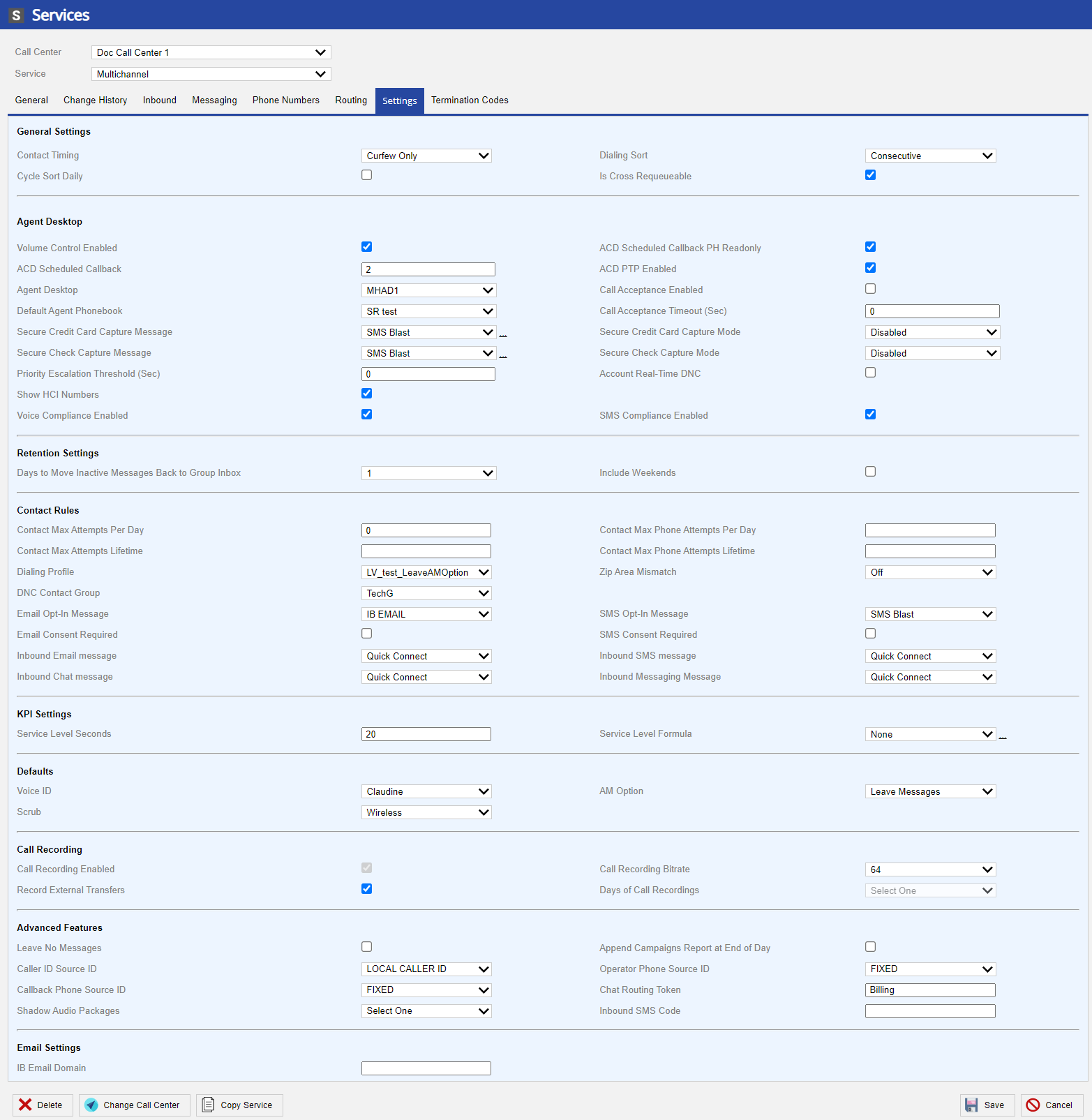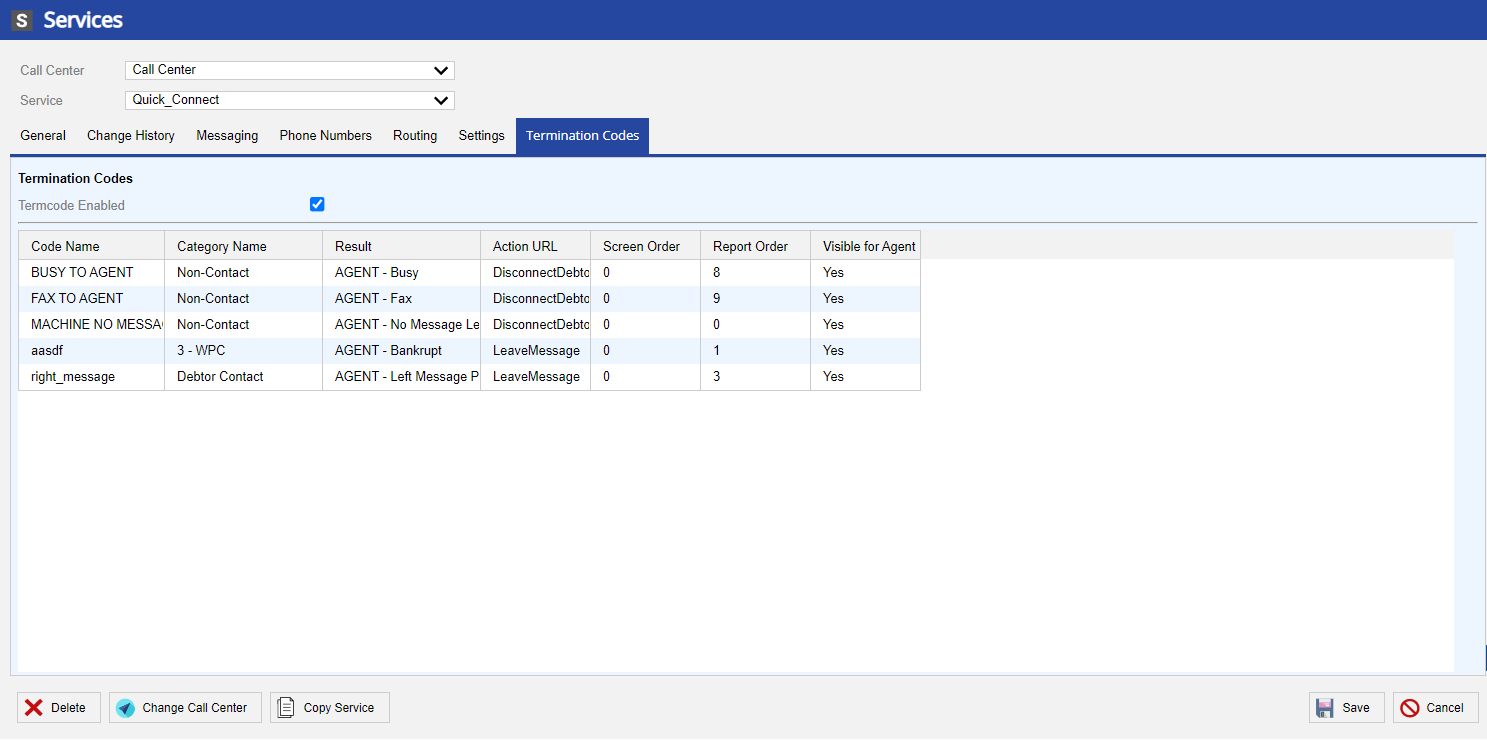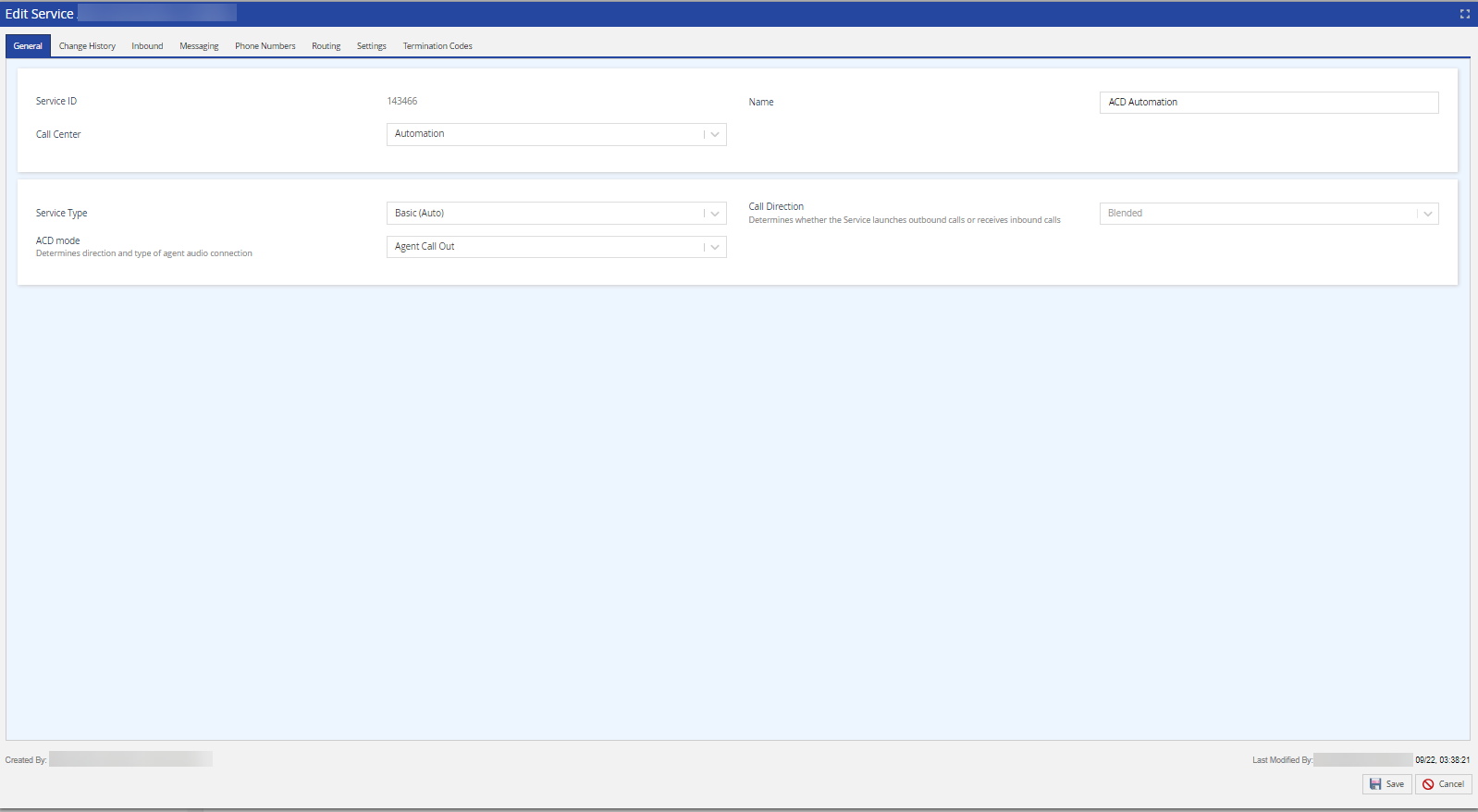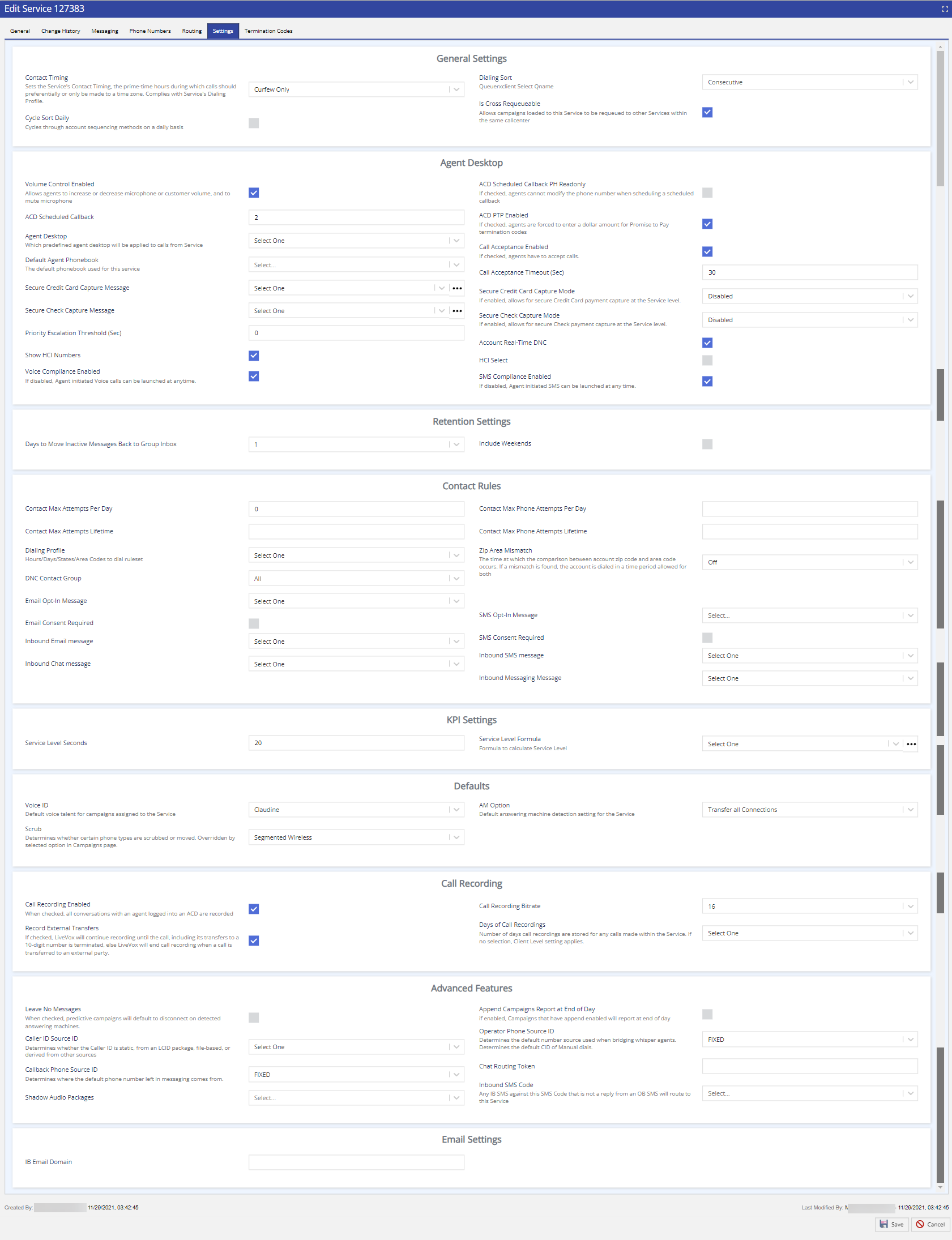U17
Services in the LiveVox Portal (LVP) contain a wide range of options that you can configure using the Services menu tabs. This article explains the tabs and includes quick-reference links to all the tabs:
- The Services General tab contains Services and Service Type sections. The Services section lists the service attributes and enables you to change the service name. The Service Type section allows you to modify service-type attributes, such as Automatic Call Distributor (ACD) mode and the Call Direction.

- The Services Change History tab contains a table with the history of all changes made to the service.

- The Services Click Distribution tab is visible only when the Human Call Initiator (HCI) or 10-Digit with Manual Transfer (10DMT) service types are selected from the Services drop-down list. This tab allows you to configure preferred click distribution at the service or service group level.
-
 The Services Inbound tab is visible only when the Inbound service type is selected from the Services drop-down list and displays the allowed inbound hours for the selected service.
The Services Inbound tab is visible only when the Inbound service type is selected from the Services drop-down list and displays the allowed inbound hours for the selected service.
- The Services Messaging tab contains the default Input Filter as well as the Properties section.
An input filter reads the data submitted in your files into a format that can be stored in the LiveVox databases for use. That is, an input filter is used to process and import the data from a file into the LiveVox Portal (LVP) through field mapping and data transformation. Mapping is the process of creating a link between the source data (file) and the target data (LVP). Individual components of a message are edited using different properties. Many common properties are explained in the Message Properties Supplemental.

- The Service Phone Numbers tab displays all phone numbers within the client portal and enables you to identify, assign, modify, and disassociate phone numbers from one service to another. This tool compiles all assigned phone numbers (Agent Dial-In numbers, Extensions, Agent Direct Lines, LCID, Inbound numbers, and Caller ID numbers) in a single view for easier management.

The Services Preview Settings tab displays only when you select either the Preview All(Preview) or Preview All (API Enabled) service types from the Service Type drop-down list under the General tab. All preview options are displayed. 
- The Services Routing tab enables you to view and select the preferred routing method - Service, Service Group, or Agent Teams.

- The Service Settings tab contains a host of settings you can configure on LVP.
-
 The Services Termination Codes tab displays the list of termination codes assigned to the service.
The Services Termination Codes tab displays the list of termination codes assigned to the service. 
LV19
Services configured in the LiveVox Portal (LVP) contain a wide range of options to configure various options under each of the Services menu tabs. This article explains the tabs and includes quick-reference links to all the tabs:
- The Services General tab contains the Services and Service Type sections. The Services section lists the service attributes and enables you to change the service name. The Service Type section allows you to modify service-type attributes, such as Automatic Call Distributor (ACD) mode and the Call Direction.

- The Services Change History tab contains a table with the history of all changes made to the service.

- The Services Click Distribution tab is visible only when the Human Call Initiator (HCI) or 10-Digit with Manual Transfer (10DMT) service types are selected from the Services drop-down list. This tab allows you to configure preferred click distribution at the service or service-group level.

- The Services Inbound tab is visible only when the Inbound service type is selected from the Services drop-down list and displays the allowed inbound hours for the selected service.

- The Services Messaging tab allows you to find the default Input Filter as well as the Properties section.
An input filter reads the data submitted in your files into a format that can be stored in the LiveVox databases for use. That is, an input filter is used to process and import the data from a file into the LiveVox Portal (LVP) through field mapping and data transformation. Mapping is the process of creating a link between the source data (file) and the target data (LVP). Individual components of a message are edited using different properties. Many common properties are explained in the Message Properties Supplemental.

- The Service Phone Numbers tab displays all phone numbers within the client portal and enables you to identify, assign, modify, and disassociate phone numbers from one service to another. This tool compiles all assigned phone numbers (Agent Dial-In numbers, Extensions, Agent Direct Lines, LCID, Inbound numbers, and Caller ID numbers) in a single view for easier management.

- The Services Preview Settings tab displays only when you select either the Preview All (Preview) or Preview All (API Enabled) service types from the Service Type drop-down list under the General tab. All preview options are displayed.

- The Services Routing tab enables you to view and select the preferred routing method - Service, Service Group, or Agent Teams.

- The Service Settings tab contains a host of settings you can configure on LVP.

- The Services Termination Codes tab displays the list of termination codes assigned to the service.

Fall 23
Services configured in the LiveVox Portal (LVP) contain a wide range of options to configure various options under each of the Services menu tabs. This article explains the tabs and includes quick-reference links to all the tabs:
- The Services General tab contains the Services and Service Type sections. The Services section lists the service attributes and enables you to change the service name. The Service Type section allows you to modify service-type attributes, such as Automatic Call Distributor (ACD) mode and the Call Direction.

- The Services Change History tab contains a table with the history of all changes made to the service.

- The Services Click Distribution tab is visible only when the Human Call Initiator (HCI) or 10-Digit with Manual Transfer (10DMT) service types are selected from the Services drop-down list. This tab allows you to configure the preferred click distribution at the service or service group level.

- The Services Inbound tab is visible only when the Inbound service type is selected from the Services drop-down list and displays the allowed inbound hours for the selected service.

- The Services Messaging tab allows you to find the default Input Filter, as well as the Properties section.
An input filter reads the data submitted in your files into a format that can be stored in the LiveVox databases for use. That is, an input filter is used to process and import the data from a file into the LiveVox Portal (LVP) through field mapping and data transformation. Mapping is the process of creating a link between the source data (file) and the target data (LVP). Individual components of a message are edited using different properties. Many common properties are explained in the Message Properties Supplemental.

- The Service Phone Numbers tab displays all phone numbers within the client portal and enables you to identify, assign, modify, and disassociate phone numbers from one service to another. This tool compiles all assigned phone numbers (Agent Dial-In numbers, Extensions, Agent Direct Lines, Local Caller ID (LCID), Inbound numbers, and Caller ID numbers) in a single view for easier management.

- The Services Preview Settings tab displays only when you select either the Preview All (Preview) or Preview All (API Enabled) service types from the Service Type drop-down list under the General tab. All preview options are displayed.

- The Services Routing tab enables you to view and select the preferred routing method - Service, Service Group, or Agent Teams

- The Service Settings tab contains a host of settings you can configure on LVP.

- The Services Termination Codes tab displays the list of termination codes assigned to the service.
